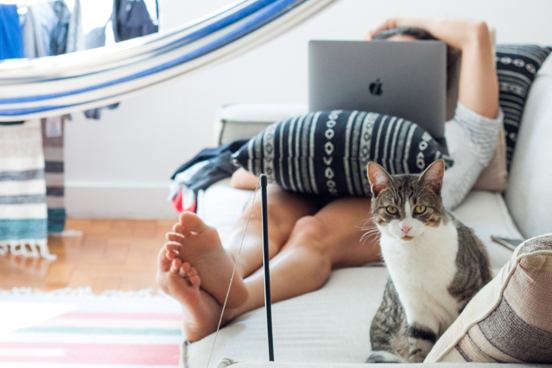DO’S AND DON’TS OF WORKING FROM HOME
As an online volunteering platform, we at Joe ProBono are very accustomed to working remotely. If you’re anything like me—your dining table has been cleared off of all clutter, your ottoman that’s shaped like an alpaca is now a glorified “ergonomic office chair”, and your cat is your newly hired receptionist. With all these abnormalities in place, it’s easy to slip into a comfortable routine and become more of a couch-potato than a bread maker. But, there are practical ways to keep your productivity up during remote work.
1. Get dressed.

If there’s anything that’s counter conducive to your productivity, it’s sitting in your matching silk pajamas with two left-foot sandals. Sure, you don’t have to go as far as an adornment full of office attire, but at least put on a top and bottom piece that’s office appropriate. Why? Because psychologically speaking, your office-clothes
are an ‘unconditioned stimuli’ to your job. In other words, your mind naturally associates being dressed to working. Plus, comfy clothes lead to…well being comfortable! Additionally, articles out right now encourage you to wear shoes, but frankly, that’s a terrible idea. Shoes only exist for outside protection, but they’re not without their downside. So, take the opportunity by the horns (err–or by the feet), and do not wear shoes! Just wear a top and bottom. It’ll go a long way.
2. Communication is key, but keep it healthy.
As we transition into remote working, learning how to communicate virtually is critical. Thankfully, there’s a ton of great platforms out there to help facilitate this that go beyond awkward emails with a million CC’ed employees. Slack and Whatsapp are some of my personal favorites, and for video conferencing, Skype and Zoom dominate the market right now (I personally think Zoom is easier to use, especially with the integrated dial-in) That being said, the biggest part of going to strictly remote work is developing trust. Let’s be honest, although it may ease your supervisor and peers initial anxieties, constantly spamming emails about not only what you’ve done and what you’re going to do and when you’re at right now is not a healthy way to facilitate trust among your company. The best advice: keep an open line of communication, send notices as you progress (but not at every increment), don’t be afraid to ask for help, and above all: take this opportunity to strengthen your independence and trust your gut, you’ll be a better employee from it as a result, and your company culture will improve as well.
3. Find an opportunity to go outside if the weather permits, or get a light therapy lamp.

Don’t mistake quarantine and social distancing for isolationism. It’ll do wonders for your productivity to get some much-needed Vitamin-D, and it’s very easy to do so. One thing my coworkers and I are doing is taking a picnic lunch in a local park that we know not many people frequent. That way, we waste no time from working since it’s during our lunch break anyway, and we’re not putting ourselves at risk with exposure. Also, I invested in a light therapy lamp (not to be confused with a tanning lamp) that uses ionic-technology to stimulate the effects of the sun. It’s a very inexpensive purchase, and mine even doubles as an air-purifier, so win-win!
Overall, working from home is challenging, but not unbearable. We hope these tips go a long way for you, but we want to know what you’re doing besides this to help ease the burden of remote work! Comment below with your creative solutions. Stay safe and stay productive!


